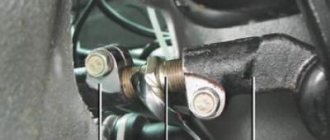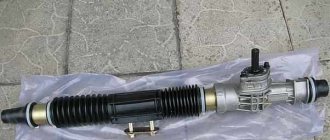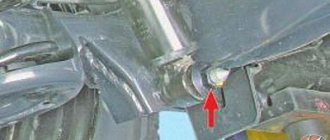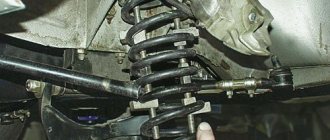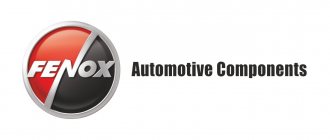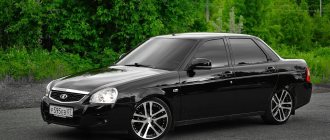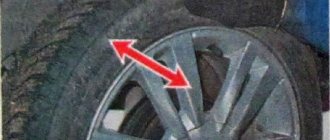Print this article Font size 16
Every motorist understands how important the front suspension of the VAZ 2110 plays. But this unit may have certain problems, characteristic malfunctions, which almost everyone who has more or less little experience in car repair can know and fix. Therefore, today we will talk specifically about the front suspension of the “tens”.
What does the VAZ suspension consist of?
1 — transverse arm mounting bracket, 2 — stabilizer bar cushion, 3 — bar cushion bracket, 4 — stabilizer bar, 5 — transverse arm, 6 — stabilizer strut, 7 — ball joint, 8 — steering knuckle, 9 — telescopic strut, 10 — transverse arm extension, 11 — front mounting bracket for the transverse arm extension, 12 — cross member.
What should you pay attention to?
If you hear a knock in the front suspension while driving, the main reasons may be:
- — Malfunctions in the rack;
- — The bolts have become loose, the stretch marks or cushions with which the cross member is equipped may have worn out;
- — The attachment to the body is loose;
- — The rubber parts have collapsed, and the knocking has a distinct “metallic” sound;
- — A “limp” or even a broken spring knocks;
- — Wear of hinges;
- — Knocking due to wheel imbalance;
- — Settlement or breakage of the suspension spring;
The car pulls to the side when driving straight. The reasons for this malfunction may include:
- — Each spring has its own compression ratio. In this case, the spring that has lost its elasticity must be replaced;
- — Tires have different pressures. We check and correct;
- — The rubber element near one of the strut supports was destroyed. At the same time, a characteristic knocking sound is also heard while driving. The problem is solved by replacing this element;
- — The wheel alignment angles are incorrect. Increased tire wear may be associated with this malfunction.
Tire wear. This may be due to improper driving (rash acceleration, braking, exceeding the permissible load of the vehicle), or other reasons:
- — violations of wheel alignment angles;
- — high wear of the hinges;
- — wheel imbalance;
When driving with increasing speed, metallic noise increases:
- — Check the wheel bearings;
- — When starting to move, a characteristic “crunch” appears;
- — Inspect the CV joints, such a sound can only be made by balls that roll along the grooves, because have too much output.
Knowing the meaning and design of the suspension, you can check its condition every time you inspect the machine on a pit (overpass) and perform maintenance. Pay special attention to the condition of the protective covers on the ball joints. Check to see if any deformations, cracks or dents have appeared on the suspension due to shaking and bumps. You should also check the tightness of all nuts.
Be sure to check the condition of all rubber and rubber-to-metal parts, as well as the ball joint of each wheel. We must remember: a malfunction noticed and corrected in time is much less evil than repairs when everything is already falling apart.
Buyer's choice: cost of support bearing VAZ 2110, its manufacturers and articles
There are many different options on the market. It is advisable to take original parts - article number: RS-67499 or 2110-2902820-RU. The width of the part is 144 mm, length – 148 mm, and height – 62 mm with a weight of 1260 grams.
However, there are plenty of other options with good reviews. Among the well-proven products are parts from the Balakovo plant, as well as products from the Asomi company. The price fluctuates between 750 – 1800 rubles. When choosing a spare part, you should pay attention to the quality of the processing of the edges of the part, as well as the packaging. In addition, the part must have certificates of conformity and quality certificates.
Table: How much does a support bearing cost for a VAZ 2110
| No. | Manufacturer | Serial number/series | Price 2022, rub. | Equipment | |||
| Bearing | Fasteners | Instructions | Guarantee | ||||
| 1 | AVTOVAZ OJSC Original | 21100-2902820-00 | 730r (1 piece) | + | + | + | 24 months |
| 2 | Lada-Image CJSC Original | 21100-2902820-88 (LADA SPORT series) | 1615r (2 pcs) | + | + | + | 24 months |
| 3 | SEVI (SEVI) Analogue | 1102-VP (with Vologda bearing) | 2320r (2 pcs) | + | + | + | 36 months |
| 4 | ASOMI Analogue | 110.2902.820-31 COMFORT PRO A | RUB 2890 (2 pcs) | + | + | + | 36 months |
| 5 | SS20 Analog | SS10104 CLASSIC MASTER | 3450r (2 pcs) | + | + | + | 48 months |
Main nodes
Let's talk about its device. The most important element of the front suspension is its strut (hydraulic telescopic) - indispensable in the matter of shock absorption, that is, ensuring a comfortable ride, without much shaking (as far as possible) over bumps and potholes on our roads. It is thanks to the rack, or rather its steering knuckle with an upper bolt equipped with an eccentric washer and a belt, that makes it possible to change the camber of the wheel.
Telescopic strut of the front suspension of VAZ 2110
The following are installed on the rack:
- Special spring;
- Buffer limiting the compression stroke, made of polyurethane;
- Upper support. Its structure is as follows: it is attached to a stand, to which the mudguard is attached with self-locking nuts. Therefore, if you make repairs yourself, do not miss this moment - you cannot use ordinary nuts;
- A bearing that makes it possible to rotate the stand together with the wheels;
- A shock absorber in which a spring and a plunger are installed for better performance.
The ball joint combines the lower parts: the steering knuckle and the lever. The longitudinal braces, lower arms, and supports that the crossbar has are connected to each other by rubber-metal hinges. With the help of special washers, it becomes possible to adjust the longitudinal inclination of the turning axis. An angular contact, non-adjustable bearing secures the wheel hubs.
Ball joint VAZ 2110
The cross member is the rod to which the lower arms are connected. It is attached to the body in the middle, helped by rubber cushions.
This, in a nutshell, is the front suspension design. Now let’s look at possible malfunctions, which in some cases can be fixed with your own hands, in others it is better to contact specialists.
Cross member VAZ 2110
Purpose
The wheels are attached to the front suspension; the unit provides shock absorption for the “front” of the car, is responsible for stability while driving, wheel adjustment, camber, and toe-in.
The front suspension design of the VAZ 2110 is quite complex, but any of you can figure it out. The main thing here is to arm yourself with an instruction manual, as well as understand the essence of the main angles.
Possible breakdowns
Knock
If you hear a knock in the front suspension while driving, the main reasons may be:
- Faults in the rack;
- The bolts have become loose, the stretch marks or cushions with which the cross member is equipped may have worn out;
- The attachment to the body has become loose;
- The rubber parts have collapsed, and the knocking has a distinct “metallic” sound;
- A “limp” or even a broken spring knocks;
- Wear of hinges;
- Knocking due to wheel imbalance.
In principle, in any of the listed cases, repairing the VAZ 2110 front suspension, done by yourself, can help, during which you need to replace a worn part or (in the latter case, the reasons why a knock is heard) - balance the wheel.
Vehicle pull to the side
The car pulls to the side when driving straight. The reasons for this malfunction may include:
- Each spring has its own compression ratio. In this case, the spring that has lost its elasticity must be replaced;
- Tires have different pressures. We check and correct;
- The rubber element near one of the strut supports was destroyed. At the same time, a characteristic knocking sound is also heard while driving. The problem is solved by replacing this element;
- The wheel alignment angles are incorrect. Increased tire wear may be associated with this malfunction. If you can’t handle it yourself, it’s better to entrust this task to specialists.
Which support bearings for the VAZ 2110 are better - Supports from SS20 or SEVI
The main question floating around the internet is which props are better for cars: SEVI or SS20? In their reviews, owners often prefer the second option. SEVI also has its advantages. Firstly, it's the price. The cost of such parts is 800-900 rubles. But the quality of workmanship leaves much to be desired - sometimes the clips can crack after only 10 thousand kilometers.
The SS20 gold element costs a lot of money. Its price is close to 1700-1800 rubles. But such elements are capable of covering significantly greater kilometers. The owners of “ten” on the forums mostly recommend this option. Below is information on how to choose the right ball bearing without running into a fake.
Review of SS20 Gold supports:
Opornik VAZ 2110 from SEVI EXTREME:
Rack support for VAZ 2110 SEVI – fake:
Suspension check
Knowing the meaning and design of the suspension, you will be able to check its condition every time you inspect the machine on a pit (overpass) and perform maintenance. Pay special attention to the condition of the protective covers on the ball joints. Check to see if any deformations, cracks or dents have appeared on the suspension due to shaking and bumps.
Be sure to check the condition of all rubber and rubber-to-metal parts, as well as the ball joint of each wheel. Remember: a malfunction noticed and corrected in time is much less evil than repairs when everything is already falling apart.
Bleeding the shock absorber
- The rack must be completely disassembled and cleaned of dirt and old oil. Check the O-rings and the condition of the inner pipe wall.
Remove drips and other contamination from all rack mechanisms - Then the assembled rod in the pipe is placed in a container with oil (you can find out the type of fluid from the characteristics of your shock absorber). Oil is drawn in with a smooth movement. The procedure is repeated several times until the air bubbles disappear. The part must be held vertically.
No special equipment is required to work with oil struts - If the stand is not dismountable, you can install a bleeder fitting at the bottom. To do this, just drill a hole, fill the stand with oil through it and tighten the screw on the sealant or weld it. In this way, owners of domestic cars with high mileage restore the performance of shock absorber struts.
Main components
The front suspension of the VAZ-2110 includes the following elements:
- Shock absorber strut with welded steering knuckle.
- The ball joint that connects the lower control arm to the wheel hub.
- A support bearing is a device mounted on the body. With its help, the stand rotates around its axis.
- Hub - with the help of this mechanism, the CV joint rotates and motion is transmitted to the wheel. Installed on the steering knuckle.
- The levers fix the suspension elements and do not allow them to move in the longitudinal direction.
Each suspension element has its own characteristics; when it fails, characteristic signs will appear. It is by them that you can determine the breakdown.
Chassis 2110
The front suspension of the VAZ 2110 is independent, telescopic. It is based on hydraulic shock absorber struts and coil springs, as well as lower wishbones with braces and a stabilizer bar.
Telescopic stand
1 – compression valve body; 2 – compression valve discs; 3 – throttle disk of the compression valve; 4 – compression valve plate; 5 – compression valve spring; 6 – compression valve cage; 7 – recoil valve nut; 8 – recoil valve spring; 9 – recoil valve plate; 10 – recoil valve disc; 11 – throttle disk of the recoil valve; 12 – piston; 13 – bypass valve plate; 14 – bypass valve spring; 15 – plunger; 16 – plunger spring; 17 – rod guide bushing with a fluoroplastic layer; 18 – guide bushing cage; 19 – sealing ring of the rack housing; 20 – rod seal; 21 – oil seal cage; 22 – gasket of the rod protective ring; 23 – rod protective ring; 24 – nut of the strut body; 25 – compression buffer support; 26 – rod; 27 – spring cup; 28 – rotary lever; 29 – rod limit sleeve; 30 – rack body; 31 – cylinder;
32 – drain tube
Front suspension assembly
1 – telescopic stand; 2 – nut; 3 – eccentric bolt; 4 – nut; 5 – steering knuckle; 6 – front wheel drive shaft; 7 – protective cover of the hinge; 8 – external shaft joint; 9 – lower lever; 10 – ball joint; 11 – decorative disk (cap) of the wheel; 12 – hub; 13 – brake disc; 14 – protective casing; 15 – rotary lever; 16 – lower support cup; 17 – suspension spring; 18 – protective cover of the telescopic stand; 19 – compression stroke buffer; 20 – upper support cup; 21 – upper support bearing; 22 – upper support of the rack;
A – control size
Steering knuckle and front wheel hub parts
1 – steering knuckle; 2 – outer mud ring; 3 – hub bearing; 4 – wheel hub; 5 – thrust washer; 6 – nut; 7 – retaining rings;
8 – internal dirt ring
https://youtube.com/watch?v=jhfbQtpuceg
Figure 1 shows part of the front suspension. It is based on a telescopic hydraulic shock absorber strut 1, the lower part of which is connected to the steering knuckle 5 with two bolts. The upper bolt 3, passing through the oval hole of the strut bracket, has an eccentric collar and a washer. Turning the top bolt changes the camber of the front wheel.
The following elements are installed on the telescopic rack: - coiled coil spring 17, - polyurethane foam buffer 19 compression stroke, - upper support 22 of the rack assembly,
— bearing 21.
The upper support is secured with three self-locking nuts to the body mudguard strut. Due to its elasticity, the support ensures the rack swings during suspension movements and dampens high-frequency vibrations.
Telescopic stand.
A hydraulic recoil stroke buffer is installed in the upper part of the cylinder, consisting of a plunger 15 and a spring 16. It limits the movement of the rod during the recoil stroke. The lower part of the steering knuckle 5 (see figure “Front suspension assembly”) is connected by a ball joint 10 to the lower suspension arm 9.
Braking and traction forces are perceived by longitudinal braces, which are connected through rubber-metal hinges to the lower arms and to the front supports of the front suspension cross member.
At the junction of the brace with the lever and the front support, adjusting washers are installed, which change the angle of the longitudinal inclination of the steering axis.
Important
In the steering knuckle (see figure “Steering knuckle and details of the front wheel hub”) a double-row angular contact bearing of a closed type is attached, on the inner rings of which the hub 4 of the wheels is mounted with interference. The bearing is tightened with nut 6 on the shank of the outer wheel drive joint housing and is not adjustable.
All front and rear wheel hub nuts are the same and have right-hand threads. The anti-roll bar is a bar, the knees of which are connected to the lower suspension arms through struts with rubber and rubber-metal hinges.
The middle (torsion) part of the rod is attached to the body with brackets through rubber pads.
How to determine the need for replacement
The silent blocks of the front levers of the VAZ 2110, at the slightest violation in installation or a certain degree of wear, quite clearly make it clear to the car owner about the problem that has arisen. The very first and most obvious sign will be the distinct sound of iron striking in the front of the car, as well as a clear change in the quality of car control.
However, such clear evidence of a malfunction is preceded by less noticeable ones:
- during the control process, the sounds of rubber squeaking are heard, and the louder, the more advanced the situation;
- while driving, there is a clear and uniform tapping sound in the area of the wheels, which indicates poor fixation of the silent block and its gradual destruction due to this;
- if the knocking becomes distinct, it is better to use a jack and examine the silent block more carefully. Perhaps its destruction has begun, as evidenced by cracks appearing on the surface. If this is the case, you need to start replacing as soon as possible.
If time is lost, the connecting elements will collapse, which will lead to wear and gaps between the elements, and the wheel alignment angles will be disrupted. This will affect the functional condition of the car and will only reduce its service life several times.
CV joints
Most often, a faulty CV joint manifests itself as a distinct crunching sound when the steering wheel is turned in any direction when driving hard. When this symptom is observed in a car, it makes sense to drive the car into a pit and check it.
In order to check the CV joint yourself, you first need to perform a visual inspection; if the boots are torn, there is a high probability that the CV joint is faulty, since the dirt that will fly under it will act as an abrasive and will accelerate wear several times.
Next, check for play. To do this, grab the drive and pull it clockwise and counterclockwise; if you feel play, it means the CV joint is faulty.
The above is not all that is included in the diagnosis. These procedures will only help determine the general condition of the main suspension components. For a more in-depth analysis of the wear of a particular element, equipment that is only available at a service station may be required.
Front wheel hub
This part of the front suspension of the VAZ-2110 is located on the steering knuckle, connected to the strut and ball joint. It contains a cylindrical bearing in which the CV joint tip rotates. Using two bolts located on the steering knuckle, the wheel camber angle is adjusted.
When making repairs, be sure to remember how these elements were installed relative to each other. Otherwise, you risk accelerating the wear of your car's tires. At the bottom of the fist there is a hole for the ball joint pin. The hub itself has four threaded holes for fastening the wheel and two for screwing in the guide pins.
Shock absorber
The basis of the entire structure is the shock absorber strut. It houses the front suspension spring. The operation of the entire mechanism is most efficient if these elements are in good condition. In particular, there must be sufficient oil inside the rack. And the spring should not be “sagging”. If the car is used in harsh conditions for a long time, the length of the spring decreases gradually. Despite its apparent rigidity and strength, the coils become closer to each other. Even half a centimeter of drawdown will make itself felt - the entire suspension will begin to work ineffectively. This is one of the elements that makes up the front suspension of the VAZ 2110. You can even repair it yourself. As for the shock absorber itself, try to keep it clean. In particular, it is imperative to change the boot if cuts or cracks suddenly appear on it. Even a small amount of dust will make itself felt very soon. The seal will certainly collapse and the oil will begin to come out.
Problems when paying with bank cards
Sometimes difficulties may arise when paying with Visa/MasterCard bank cards. The most common of them:
- There is a restriction on the card for paying for online purchases
- A plastic card is not intended for making payments online.
- The plastic card is not activated for making payments online.
- There are not enough funds on the plastic card.
In order to solve these problems, you need to call or write to the technical support of the bank where you are served. Bank specialists will help you resolve them and make payments.
That's basically it. The entire process of paying for a book in PDF format on car repair on our website takes 1-2 minutes.
If you still have any questions, you can ask them using the feedback form, or write us an email at
We will replace
— Overhaul of the engine - overhaul of the removed engine - removal and installation - oil in the hydraulic booster - oil in the engine VAZ 2110-2111-2112, Lada Priora, Largus - engine valves - brake piston ring pads - gearbox mechanical repair - steering knuckle assembly - sump - engine crankcase - Spark wheel bearing - exhaust pipe Alexander Kalyuzhin, 2022. - cylinder head gaskets VAZ 2110-2111-2112, Lada Priora, Largus - valve cover gaskets - rear or front springs - radiator VAZ 2110-2111-2112, Lada Priora, Largus - camshaft - steering rack mechanism - steering tip left or right - steering rod right or left - lower front suspension arm right or left - rear hub - starter VAZ 2110-2111-2112, Lada Priora, Largus - front hub with knuckle and brake disc assembly - clutch - fuel pump - fuel filter - ball joint VAZ 2110-2111-2112, Lada Priora, Largus - ball joint with rivets - Daewoo internal CV joint - CV joint, Spark external - CV joint, external boot - cabin filter, oil Alexander Kalyuzhin, 2022.
Typical faults
The front suspension is characterized by certain breakdowns, which are determined by two phenomena:
They should be considered separately, since the reasons for their appearance are different.
Knocks
If you start to hear knocking noises coming from the front suspension, this could be caused by several reasons:
- The rack has certain faults;
- The ties on the cross member, the cushions are worn out or the bolts are loose;
- The attachment to the body was not strong enough;
- The springs have failed;
- The hinges are worn out;
- The rubber part of the suspension has broken its integrity. The knock should be clear, like the impact of metal on metal;
- Wheel alignment is out of balance.
If you do not hear a knock, but a noise, then the causes of front suspension problems may be as follows:
- The bolts that secure the stabilizer bar to the body have become loose;
- The rubber components in the strut support have collapsed;
- The rubber pads of the coupler or rod are worn out;
- The suspension spring has broken or violated its geometry;
- The wheels are unbalanced;
- The compression stroke buffer has collapsed.
Increased tire wear
If you are not a fan of fast acceleration, harsh braking, or do not overload the car, then the reasons for increased wear may be:
- The wheel alignment angles are incorrect;
- The hinges are worn out;
- Wheel balance is off.
